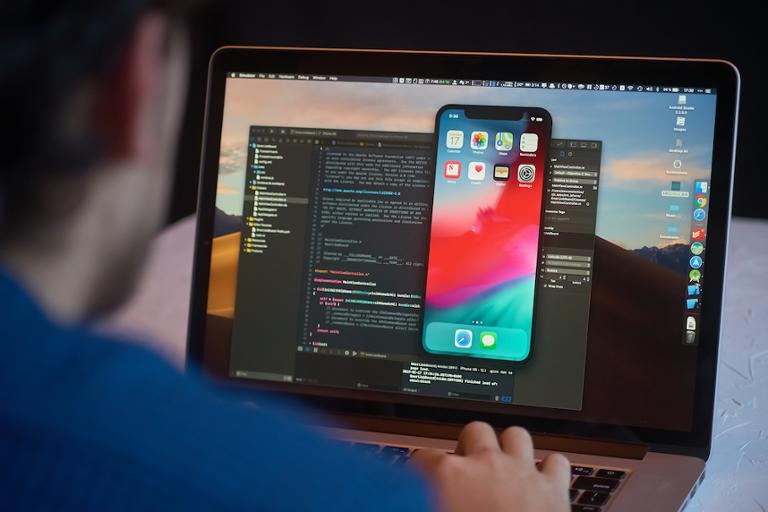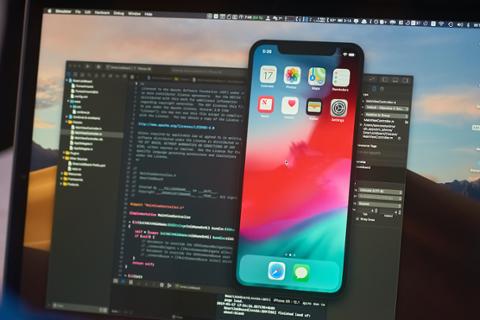So you have a great idea for a native app, but you're not sure about how to build it and where to begin on the development side.
One of the first few questions you’ll need to ask yourself is which programming language is the best fit for what you’re trying to build, and what’s the best path?
Let’s start with the basics. Native apps are those built for a specific OS. For example, take the difference between a mobile webpage you bring up on a browser and an app such as Instagram that you download to your device. Unlike a web app, a native app gives you the ability to send push notifications and quickly share data from one app to another.
These platform-specific apps interact seamlessly with all other facets of a smartphone or other mobile device, allowing the app to instantly interact with the user’s camera, microphone, or geolocation. The lattermost example benefits the app-maker, allowing them to customize their offerings and rewards based on location while the user can take advantage of nearby deals or storefronts.
Do you value app-speed on the front end? Something easy to manipulate on the back end? Both? As you familiarize yourself with platforms and surface-level programming, the decisions of how, when, and why to use a specific language become more clear.
Understand Your Development Platforms
Knowing which platform to build your native app upon depends on knowing if your user base tends to congregate on iOS, Android, or both. With a great app idea in mind and an understanding of your target market, you can more confidently shop for languages on a given platform. Let’s take a look at some of the most popular ones below:
Best Coding Languages for iOS:
Objective-C
Objective-C, long considered Apple’s default language, has been going strong since the 1980s. By virtue of being the standard-bearer in iOS for so long, this all-purpose programming language has an extensive library and is known by almost any Apple developer.
Another major benefit of using Objective-C is its stability. Once you develop your app on the language, you won’t need to spend lots of time on updates and new versions. Unfortunately, Apple seems to be shifting away from Objective-C. Its performance is a bit limited and does not include the modern features of newer competitors.
Swift
If Objective-C represents the present, Swift is certainly the future of iOS. Apple is clearly trying to make Swift its go-to coding language. As more emphasis gets put on Swift, it should be at the top of any conversation when choosing an iOS language. Simply put, Swift is the new and much faster version of Objective-C.
In addition to a faster development process, other pros of using Swift are its easy scalability and a safety system that prevents code crashing. On the flip side, Swift is still a relatively young language, so its library and resources are limited when compared to Objective-C. Another consideration is there are fewer Swift developers out there when compared to its predecessor; however, that’s expected to change in the coming years.
Python
This ever-popular language is especially useful for mobile apps that leverage large amounts of data and/or machine learning. Python is able to easily crunch big packages of data and interpret them for developers. Netflix, Reddit, and Facebook are among the big-name users of Python for these exact reasons.
Although Python was originally meant to be a scripting language, it is one of the most popular languages for native app developers because of its ability to handle enormous datasets. It’s also preferred for its extensive third-party library options, which give it an advantage over Swift when working on back-end apps. Another benefit of Python is that it’s easy to understand, so you have a wide base of developers who can utilize it, and it can be integrated with other popular languages such as Java.
RubyMotion
In 2012, RubyMotion was released and challenged Objective-C’s stranglehold over iOS mobile app development. By allowing programmers to use Ruby’s much-beloved language to create native apps, RubyMotion still provides an interesting alternative to the more popular options listed above.
Technically, RubyMotion can be used as a cross-platform language, but it is routinely used for iOS development. It’s known for running very fast and giving developers a variety of testing tools. Since RubyMotion is a cross-platform language, one major downside is that once you write your code in Ruby, you will still need to learn the host API, which will be written in Objective-C or Swift.
Best coding languages for Android:
Java
The official language of Android is also its most popular. Keep in mind that Java is flexible and can be an option if you’re ever interested in developing cross-platform apps. For native app developers, it also has plenty of perks. As Android’s default language, it has a wide variety of libraries and a good selection of open-source material to work with. It tends to allow for the faster user experience than other Android languages.
Some of the drawbacks of Java include the fact that it’s a complicated system to learn and not advised for use among novice coders. In addition, doing simple tasks can feel arduous as an excessive amount of code is needed for relatively minor commands. The more code that’s written, the more it can then lead to errors.
Kotlin
One of the main alternatives to Java is Kotlin, an open-source language created in 2011. Kotlin can be an attractive choice over Java because the code writing process is easier, resulting in a shorter, more compressed code (making it less likely to produce errors). Kotlin is also flexible and can be easily converted into Java, as it has access to the same libraries.
A downside of Kotlin is that it tends to be slower than Java overall. Additionally, since it’s one of the newer Android languages, there is limited help from developers and programmers compared to Java.
C/C++
Though these languages are considered more complicated than others on this list, C/C++ provides a lot of flexibility. Whether you’re looking for a low-level program or something more sophisticated like a graphical user interface (GUI), these languages can do the job. As a compiled language, which we’ll talk more about shortly, it is an extremely fast option for native apps. And thanks to its popularity among developers, there is a huge community readily available as well as countless resources via libraries and compilers.
C/C++ should be avoided if working with beginner programmers because of its sheer complexity. For those that have it mastered, there are tons of positives. It also follows a similar syntax to Java, providing some leeway in the learning curve.
Lua
Though Android does not support Lua by itself, the language is often converted to the OS by using an Android Software Development Kit (SDK). It is most commonly used for gaming apps and is recognized as a very fast, high-level language that is relatively easy to use.
Another major upside is that it does not take up much memory and can easily be transferred to the C/C++ languages, which is part of what makes it so useful for Android. Since Lua is not super common, it has limited resources and could require more time for developers to script their own code or fix problems.
Cross-platform Coding Languages:
C# and Xamarin
Microsoft’s programming language C# is ideal for Windows apps, but its code can be cross-compiled and run on iOS and Android for native apps. This is thanks to Xamarin. Apart from needing just one base code even when used across platforms, another benefit to C# is there aren’t any lags or issues with speed. For Android, C# is also often simpler to use than Java because of its straightforward syntax.
However, there is a limited pool of resources and knowledgeable developers that work with Xamarin. Additionally, apps built with Xamarin are normally twice the size as your average native app.
HTML5
Though HTML is normally reserved for web-based applications, its programming language can be transferred to native apps through third-party software (most notably Apache Cordova). This gives you features and the feel of web browsing on an app.
The fifth revision of HTML is easy to use, making it the perfect programming language for beginners. On paper, you should also save on costs, since you’re not required to pay royalties and it can be used across devices. However, if you transition HTML coding to both iOS and Android native apps, you’ll likely need to pay two different programming teams. Also, be mindful of the overreliance on third parties to make sure your native app is working as it should. When errors in the app occur, it takes valuable bandwidth and time to get those corrected.
React Native
It’s been five years since Facebook released React Native, which immediately stirred up attention for being a new and promising addition to cross-platform coding languages. The framework allows for native apps to be built on both iOS and Android, and is lauded for its short development time. One obvious advantage is that you only need to make code once and then you can use it for both of the major operating systems. It’s also usually cheaper to go this route. Since React Native is based on JavaScript, you’ll likely only need a JavaScript developer to help implement the language.
Since React Native has an excited young community of developers backing it, it’s soon to have even more tools at its disposal. Naysayers have complained about apparent bugs that hamper navigation and by virtue of it being a cross-platform language, there is the potential for having any custom modules your developers build end up in a variety of codebases.
Dart
Google’s UI framework Flutter has developed a new multi-platform language known as Dart. As with other cross-platform languages, Dart’s appeal comes from the ability to use one codebase that works on iOS, Android, and the web. Dart also comes equipped with an expansive core library, and has a number of useful tools like Dev_complier that can speed up the development process.
Dart also receives high marks for being easy to learn, but it still has a small community and has yet to become as competitive as some of its cross-platform rivals.
With all of these choices, it can be daunting to arrive on the correct decision when picking a language for your native app. Here are some things to consider to help guide you to the correct choice.
Understanding Your App’s Expected Performance Ability
Coding languages can vary greatly depending on syntax, typing, and level. When looking at the differences in implementation, there are two distinctions to be made: compiled and interpreted languages.
Compiled languages follow a static process where the program is directly converted into code by its target machine. Interpreted languages require a different program to read and carry out code. The approach here is more line-by-line execution, as opposed to compiled languages that have code manually laid out beforehand.
So what does it all mean? Well, it depends on how you look at it and how much experience you have with both platforms. While compiled languages have the luxury of running faster with fewer problems, they’re not always advantageous. Interpreted languages allow developers more freedom, since going line-by-line means code can be modified while running and it offers dynamic typing that compiled languages don't offer.
Some common examples of compiled languages that we’ve mentioned are C#, Java, Kotlin, Objective-C, and Swift.
For interpreted languages, the most popular codes include Python, Ruby, PHP, and JavaScript.
Availability of Resources for Programmers
One of the most important factors when considering which programming language to use for your native app is the number of resources available for each language. When it comes to resources, you’re likely looking for two things: First, you want a language with an established community of programmers you can tap into for help. Second, it is important to find a language with an expansive library of open-source solutions so the programmers you hire don’t have to reinvent the wheel when working on every update or error.
Languages with a large community of programmers include Python, Java, and C#. Python is revered by both beginners and more experienced programmers because it is simple, yet has a large range of applications. Since Python boasts a wide variety, from popular mobile apps like Instagram to artificial intelligence, there is a high supply of in-demand programmers.
Some notable languages with a voluminous library of solutions include Java and PHP. Java has around 400,000 different libraries and has received high marks for its wide selection of resources for programmers that work most commonly on Android. However, it can be used across other platforms, as well.
Though these languages work for many people, there may be something special you’re looking for when building your native app. The beauty of there being hundreds of programming languages on the market means you’re certainly not lacking options.
Once you’ve narrowed down your target platform for your audience and get a feel of how you want your app to perform, the options become more clear. That puts you one step closer to finding the perfect language for your new native app.
Camilo Usuga is the CTO and Head of Product at Talos Digital.



